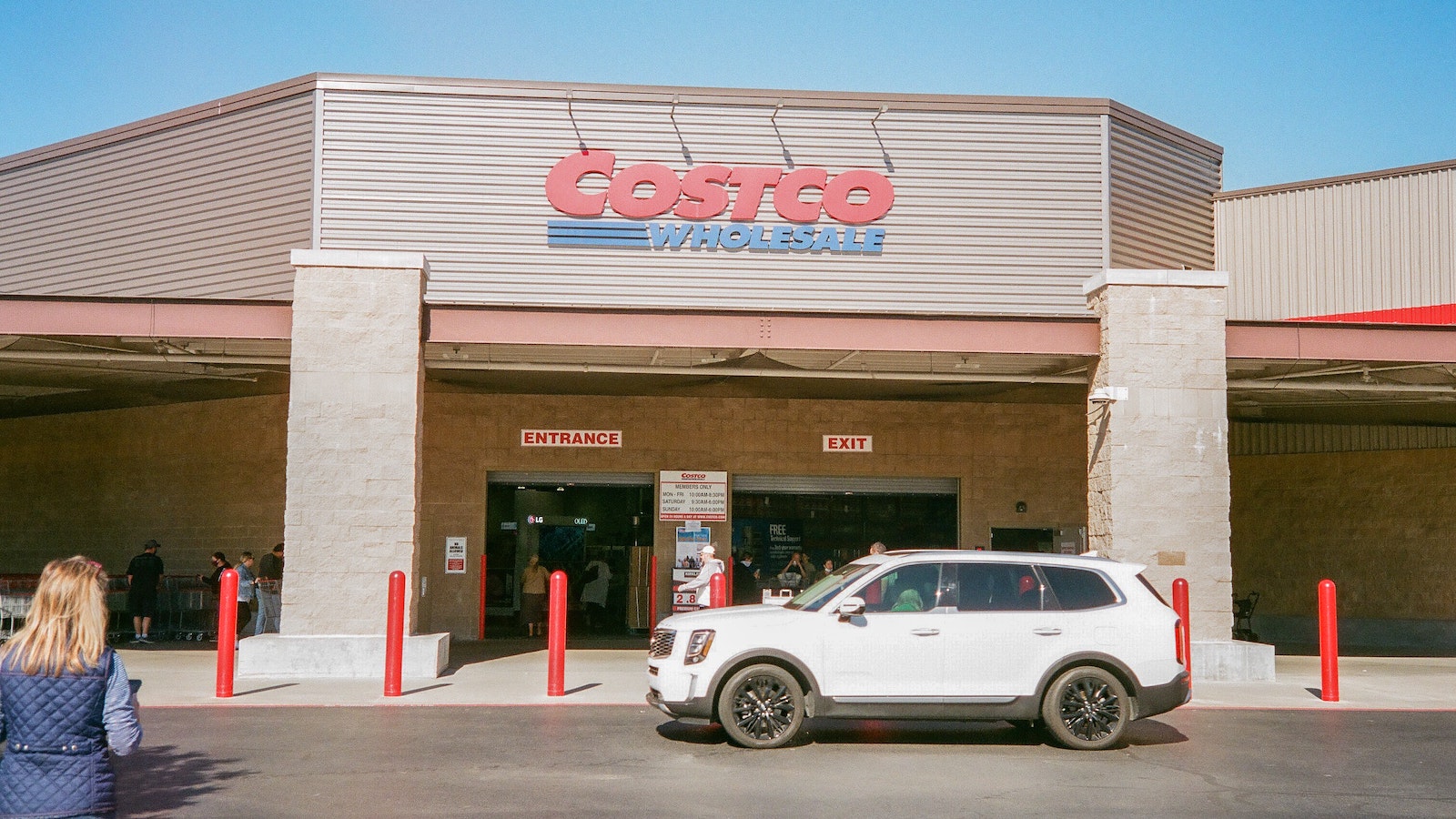Table of Contents
** Minutes
Examples of social commerce in action
Selling on social media platforms
Why social commerce is becoming so popular
Social shopping trends and statistics
How to get started selling on social media
How ShipBob enables companies to manage fulfilment for social commerce
In recent years, social media platforms have begun rolling out more robust native purchasing capabilities.
Social media itself has been a driving force for brand discovery for many years now, but that final step of completing a purchase has historically happened on a retailer’s website or app.
Social commerce aims to give users a frictionless experience that makes it easier than ever to make a purchase without ever leaving the social environment.
In this article, we cover what social commerce is, advantages and drawbacks, and how to get started selling on social media.
What is social commerce?
Social commerce is a growing sales channel (see chart below) that is a subset of ecommerce and refers to transactions that fully take place within a social media platform.
Also known as social shopping, social commerce aims to provide a seamless, streamlined experience for shoppers, enabling them to not only discover a product of interest that is being advertised through social media, but to actually purchase that product without ever leaving the social platform itself.


Social commerce can also refer to socially-driven purchases that aren’t completed in-app. This broader definition includes transactions where shoppers click a direct social link that leads back to the retailers’ website, where the actual checkout process is completed.
With that in mind, it’s also important to consider what social commerce is not.
In the past, social commerce was sometimes defined in a much broader sense, including any purchases that were at least partly influenced by a brand’s organic social media presence, and/or advertising efforts.
Others defined it a bit more specifically, only including instances where some element of help or interaction was available for prospective customers, such as brands being available to answer questions through chat.
Today’s narrowing of how we define social commerce has occurred for a few key reasons:
- It is now considered “a given” that growth-focused brands have a robust paid social advertising program, with expectations of a curated shopping storefront growing as well. While this might have been a “nice to have” a decade ago, it is essential for companies of all sizes today.
- Similarly, it is expected that a brand’s social presence will play various roles in their full-funnel marketing strategy, and simply advertising your products or services doesn’t count as social commerce.
- The options to transact natively within the platforms are continuing to grow, and along with that, the definition of social commerce is evolving.
In this article, we’ll primarily focus on providing a true, one-stop social and shopping experience that lives fully within the social platform.
However, given the flexibility of the social commerce definition, and the current options available from social media platforms, both in-app purchases and social-driven purchases will be considered.
Examples of social commerce in action
With “98% of US social media users who follow at least one brand planning to make at least one purchase via social or influencer commerce this year,” according to eMarketer.com, the opportunity for brands and advertisers is clear.
But what does that social shopping experience actually look like?
Let’s dive into a few top social commerce platforms to see.
Selling on social media platforms
The majority of top social media platforms have existing, and expanding, social commerce capabilities.
Here we’ll explore what some of the options on those platforms include, focusing on Pinterest, Meta, and TikTok.
Social shopping on options on Pinterest
Pinterest is an advertisers’ paradise, because the majority of users on the platform are actively interested in discovering new things.
In fact, 72% of surveyed Pinners reported that “Pinterest inspires them to shop when they aren’t actually looking for anything.”
If you’re working with a performance marketing agency for your Paid Social campaigns, they can help determine which Pinterest ad options and shoppable features are the best fit for your brand.
Those options include:
- Shoppable Product Pins
- Dedicated ‘Shop’ tab on your brand profile, and in-app
- Shoppable Collection Ads
- Dynamic Shopping Ads
- Shopping List
- Shoppable Spotlights
- Shop from Boards
- Promoted Pins
Before brands can sell on Pinterest, they must first set-up a Catalogue , “a feed ingestion tool designed for businesses that sell products on their websites.”
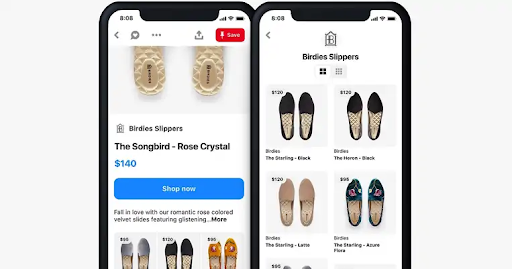

Social shopping options on Meta (Facebook & Instagram)
- Facebook Shops & Instagram Shops
- The virtual storefronts are free to create, but incur fees when native checkout is used.
- A separate, in-app ‘Shop’ tab makes it easy for shoppers to find available products for purchase.
- Instagram allows brands to sell products directly from their posts, Instagram messages, or Instagram Stories.
- Facebook allows ecommerce businesses (and local sellers) to enable purchases through Facebook Marketplace.
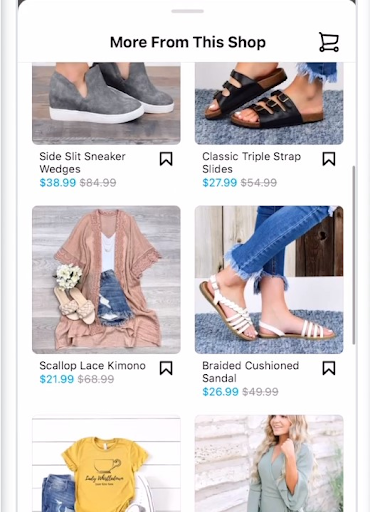

Social shopping options on TikTok
- Direct Integration: Products are uploaded and managed directly for a “full commerce experience,” including fulfilment and shipping
- Product Links: Allow brands to highlight one or more products, leading to product detail pages, within an organic TikTok video
- TikTok LIVE shopping (see below)
Selling within live streams (live shopping)
Connecting with consumers through live shopping is on the rise.
TikTok is among those doing it best, enabling brands to share dynamic links for the products and services they’re discussing and reviewing, in real time.
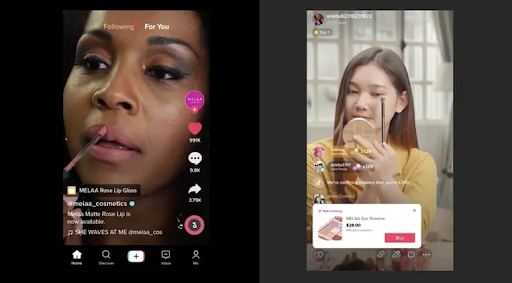

Promoting a brand or product via social media with influencers
Brands are increasingly relying on influencer marketing to help generate authentic, on-brand, personality-packed content that will resonate with their target audiences.
Influencers are active social media users who have earned a dedicated following who trusts their opinion on products and services.
Influencers fall within a range of categories, largely dictated by the size of their following, giving brands the opportunity to find the influencers whose overall reach and audience best aligns with their influencer campaign goals.
Why social commerce is becoming so popular
The COVID-19 pandemic brought rapid changes to ecommerce, social commerce, and more broadly, how we shop, where we shop, and why we’re shopping that way.
Trends that were already in place, including social commerce, saw some of the fastest adoption rates as shoppers and businesses were already testing those waters before personal safety became a part of the shopping conversation.
As much of the country sat sheltered in place, the reliance on social media to stay connected, and entertained, and shop, was greater than ever.
With real fears of contracting or spreading the virus, and more time spent scrolling on the couch, many consumers’ shopping habits quickly evolved toward digital-first experiences.
Turns shopping into a social experience
While many of us still enjoy in-person shopping trips with friends, the social side of shopping has naturally been reduced as shoppers of all ages make more of their purchases online.
Social commerce is a part of the broader puzzle that aims to make shopping an experience again, and not simply a transaction.
Whether you’re sharing links with your friends on Instagram to get their opinion on a dress before you buy it, or you’re joining a live shopping event and sharing your reaction in the chat, we get to experience a modern day version of a Friday night at the mall in the 1990s.
Engages your audience where they’re most comfortable
Social commerce is about meeting your shoppers where they are and providing them with a clear path from discovery to consideration, to conversion.
When executed well, it is a win-win-win opportunity, with brands, users, and the platforms themselves all benefitting.
Brands benefit by making it easier for shoppers to shop. Social media users benefit by being able to purchase what caught their interest and get right back to the scrolling they were doing before that interest was piqued.
And the social platforms themselves benefit by keeping users within their environment, building on their own user-insights, but also simply increasing time-in-app. After all, they don’t want users to forget to come back after making a purchase.
Focuses on the exact audiences and markets you want to reach
Social media advertising (and social commerce, by extension) gives brands an opportunity to be specific in their targeting.
While some brands do prefer to cast a wide net for brand awareness campaigns, for lower-funnel tactics, you are able to reach the right demos for your brand, targeting by interests, location, and more.
Social shopping trends and statistics
What’s the future of social shopping looking like?
Here is a breakdown of some interesting trends and statistics.


- It’s estimated that about half of all US adults made a purchase via social media in 2021.
- Insider Intelligence projects that social commerce will be a $79.64 billion industry in the US by 2025.
- The same report forecasts that “U.S. retail social commerce sales will rise by 24.9% to $45.74 billion in 2022.”
- 70% of shoppers are looking to Instagram for their next purchase.
- About 37% of shoppers say they’ve made a purchase on social media.
- Pinterest users utilising the app’s shopping features increased 60% from last year.
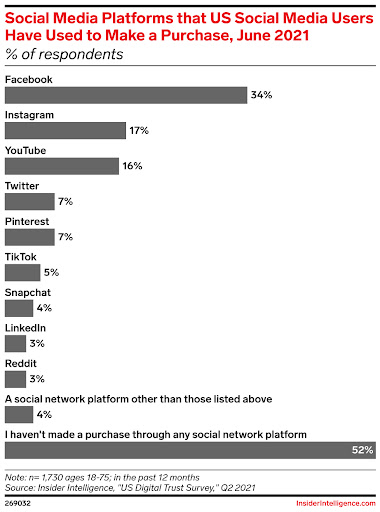

Drawbacks and risks of social commerce
While we feel the benefits social commerce offers outweigh its disadvantages, there are a few reasons some brands have hesitancy.
Let’s look at a few of the drawbacks of social commerce from a brand’s perspective.
Harder to control your brands’ narratives and brand experience
Brands put a great deal of time, effort, and money into creating a positive user experience (UX) on their website and/or app. Every colour, font, CTA button, white space, word and more is chosen carefully, then tested, analysed, and optimised.
Brands want to make it easy and enjoyable for shoppers to find what they are looking for and get the information they need about a specific item, so they can move confidently toward making a purchase.
They have built-out solid product descriptions, informational videos, and have worked hard through various marketing campaigns to grow their reviews.
This control extends to the cart, with companies applying rigorous, ongoing testing to ensure no order is left behind due to a hiccup in the checkout experience.
Much of that control is lost with in-platform social shopping. However, it’s important to remember that every other business selling on social is also forgoing that control since the social media platforms are dictating the layout, design, and functionality of the stores that live there.
This is where it’s important to consider that shoppers understand they aren’t getting the same experience they would on your site.
Social shops are built to make it easy for quick decision-makers to see something they like and purchase it in just a few clicks.
And as social shopping increases, that process will be streamlined even further as users become more familiar with each social platform’s checkout, and/or store their credit card information (or Apple Pay, Google Pay, PayPal, etc.) to save time on their next purchase.
You are giving up some website traffic and customer journey data
When shoppers make a purchase on your website, you’re able to gather useful, privacy-compliant first-party data that helps in understanding who your customers are, and the journey they took from awareness to cart.
When that transaction happens off-site, some of those insights are lost, as is the traffic itself.
But what’s not lost is the sale. It’s again important to consider the transaction from the shopper’s perspective.
You sacrificed some control, site traffic, and insights to make it as easy as possible for them to make a purchase, and increased conversions is the overarching goal for almost every business.
Negative sentiments can spread like wildfire
While every brand strategy is built on an array of goals, those goals all fall within a hierarchy, with shopper satisfaction sitting at the top.
Simply put, not much else matters if the folks actually buying your products aren’t happy with the experience.
Not only will that make them unlikely to shop with you again, but it can also result in negative customer reviews that impact your reputation and decrease the likelihood of new customers giving your brand a chance.
We have all seen the speed at which the world of social media moves and it is dizzying! With billions of users across platforms posting, commenting, liking, and sharing, both positive and negative experiences can spread quickly.
It’s important for brands to use social media monitoring tools to track these conversations and to respond just as quickly, letting customers know that they are working to resolve the issues.
If a concern is best followed-up on privately, we recommend first leaving a comment, letting them know that you or another member of your team will be reaching out to learn more.
This ensures you’re respecting their privacy, handling the specifics of the issue in a direct manner, and making it clear to prospective shoppers you respond quickly to concerns.
Social commerce is most commonly engaged in by shoppers who are active on social media. After all, social is where they saw your ad.
Having a strong social presence can mean that even a slight misstep in the order fulfilment process can trigger a public-facing response if they’re unhappy, which could impact your reputation, or slow your social commerce growth while shoppers wait for you to work out the kinks.
Surges in sales can surpass your ability to fulfil them
Too many orders may sound like a good problem to have, but if those orders aren’t fulfiled quickly and accurately, it can result in a poor user experience.
Before launching any marketing campaign that aims to increase exposure and conversions of a product or group of products, it’s important to get the logistics squared away. Ensure your warehouse itself, warehouse team, and suppliers are equipped to meet a potentially rapid influx of demand.
The importance of seamless order fulfilment is even more important in social commerce as shoppers are still in the ‘trying it out’ phase.
Social commerce is all about speed, taking shoppers from discovery to purchase in just a few clicks; if it takes you weeks or longer to fulfil those orders, those shoppers aren’t likely to react as quickly again—and may leave comments about their experience that can impact future new sales.
3PLs like ShipBob enable brands selling on social platforms to outsource their order fulfilment, picking and packing, warehousing, and inventory and returns management to logistics experts, reducing costs, improving fulfilment KPIs, and enabling businesses to focus on growth.
This is a route to consider if you’re concerned about managing fulfilment from an additional revenue stream to the existing fulfilment needs you’re already handling.
How to get started selling on social media
Now that you have an understanding of what social commerce is, it’s time to think about your social commerce strategy and how to integrate sales prospecting tools and techniques for better social commerce.
Every online business will tackle social commerce differently based on the products they sell, their audience, and goals.
But for most, there are a few steps you can take to get started. Here is an overview of how to gets started on social media.
1. Find your audience
First, you’ll want to research which social platforms your audiences are using most frequently.
Start by identifying the age groups that are most important to reach, and see which 3 top platforms have the highest number of users within that range.
2. Choose your platform(s)
Next, you’ll want to dive a bit deeper into those top platforms you’ve identified to see not only how many users are engaged, but how they are using the platforms.
For example, while there might be a smaller number of users within your target audience using Pinterest than Facebook, you’re reaching an audience on Pinterest that is highly likely to be in product discovery mode while using the platform.
3. Create your strategy
Will you try to break into the space with the help of influencers, or perhaps take it to the next level, proactively building and curating an online community around your brand?
Top considerations to guide your decisions are your budget, the bandwidth you have to support your plans, and your primary goals.
4. Start small, but with scale in mind
The world of social media is expansive with new opportunities to scale your brand being developed as we speak.
If you’re new to the social game, begin building your presence across the most established platforms first, including Facebook and Instagram.
These are the mature platforms on which nearly every business can find an engaged audience, no matter your niche. Once you have some actionable insights from those campaigns, consider expanding your reach into additional avenues.
Conclusion
Ready to dive in and see how social commerce can help you reach new audiences, grow your business, and make the whole process easier for customers? Contact Tinuiti today to chat— we look forward to learning more about your goals, and how we can help you reach them!
How ShipBob enables companies to manage fulfilment for social commerce
Lean on the fulfilment-related drawbacks from a previous section. The goal of the section is to position ShipBob as the 3PL provider that can manage order fulfilment & inventory management for social commerce at scale.
Social commerce FAQs
Here are answers to questions related to social commerce.
What are types of social commerce?
The types of social commerce are likely to grow and evolve over time, with some of the most popular types today including: buying and selling products through platform-native shops, including Facebook Shops and Instagram Shops; directing shoppers from social media platforms to your website through product-tagged photos and videos; live shopping experiences reminiscent of QVC and HSN, with dynamic links (ie. TikTok LIVE); peer-to-peer or ecommerce sales made through a community marketplace (ie. Facebook Marketplace).
What is a social commerce strategy?
A social commerce strategy dictates how you will execute and measure your social commerce presence and campaigns.
This includes, but is not limited to: deciding which platforms you’ll sell on; deciding which products you’ll promote and/or include in your social shops; building an advertising strategy that supports your defined goals.
It’s important to remember that in a social commerce environment, Shops and other shopping elements (ie. product tags) will have the same general look, layout, and feel across all brands.
You’re still conveying your brand-specific messaging through your content and ads, but the environment in which customers will actually transact is platform-dependent.
Is social commerce growing?
Social commerce is growing at a rapid pace. An eMarketer projects that US Retail Social Commerce Sales will continue to steadily climb over the next 3 years, reaching a projected ~$79 billion by 2025.

